Meat and the Maker
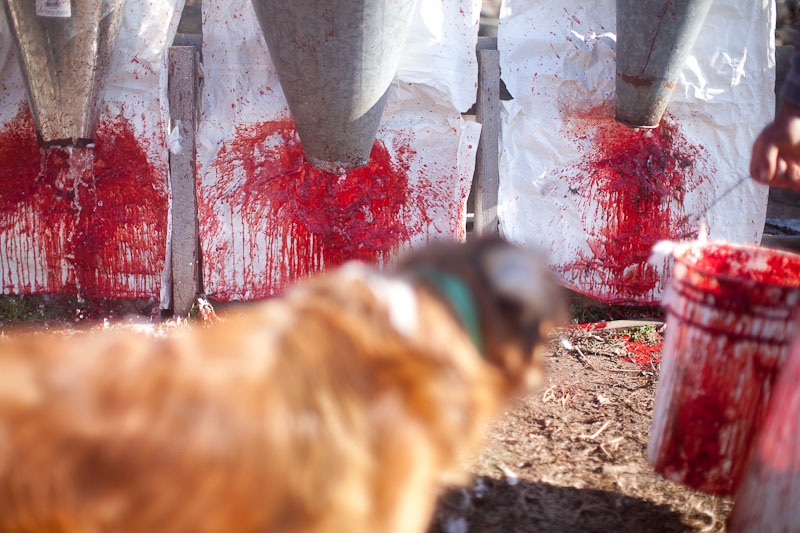 In July, I wrote about taking our four beloved Buff Orpintons to the butcher. And from that post, it’s probably clear that I can be a bit sentimental about killing animals. That cold morning I remember searching their eyes for clues: did they feel betrayed? And even though it wasn’t me who slit their throats, did I have the right to determine their premature fate?In the absence of definitive answers, we’ve plodded ahead holding close to these questions and the hope that we’d eventually find comfort in our role as animal-steward-turned-executioner.Autumn on the farm means the butcher block for many of our stock – or as we call it here at Farm School, ‘Graduation.’ With winter closing in, the gift of green pasture our grazing herds depends on disappears until spring, which means that any extra meat weight they gain comes at a high cost in hay and work.
In July, I wrote about taking our four beloved Buff Orpintons to the butcher. And from that post, it’s probably clear that I can be a bit sentimental about killing animals. That cold morning I remember searching their eyes for clues: did they feel betrayed? And even though it wasn’t me who slit their throats, did I have the right to determine their premature fate?In the absence of definitive answers, we’ve plodded ahead holding close to these questions and the hope that we’d eventually find comfort in our role as animal-steward-turned-executioner.Autumn on the farm means the butcher block for many of our stock – or as we call it here at Farm School, ‘Graduation.’ With winter closing in, the gift of green pasture our grazing herds depends on disappears until spring, which means that any extra meat weight they gain comes at a high cost in hay and work.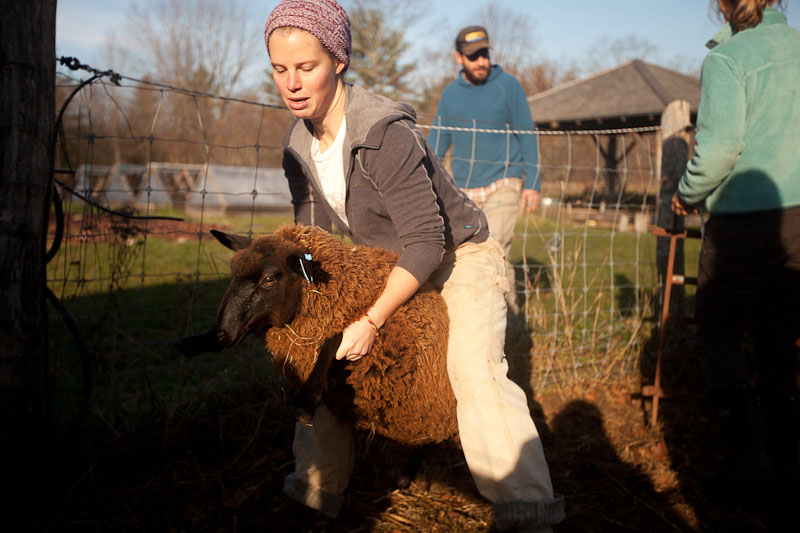 As we’ve loaded dozens upon dozens of beautifully formed yet reluctant animals into trailers, we mused aloud our pangs of sadness, imagining what the next 24 hours had in store for them.But the times that we undertook the butcher’s role ourselves, there was no need for imagining: one look into a bucket of freshly severed turkey heads with their still-blinking eyes made the gritty reality of slaughter quite concrete.
As we’ve loaded dozens upon dozens of beautifully formed yet reluctant animals into trailers, we mused aloud our pangs of sadness, imagining what the next 24 hours had in store for them.But the times that we undertook the butcher’s role ourselves, there was no need for imagining: one look into a bucket of freshly severed turkey heads with their still-blinking eyes made the gritty reality of slaughter quite concrete.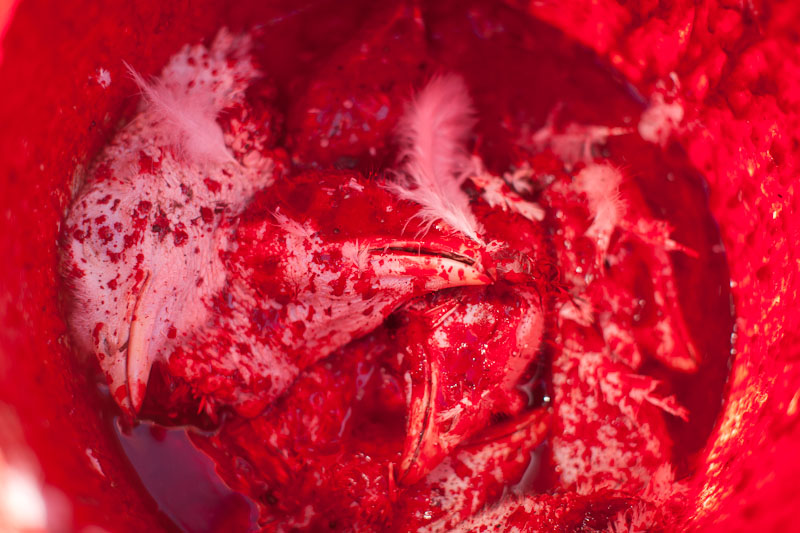 The days I’ve spent ‘graduating’ poultry have stirred still more questions: Where does an animal’s pain and suffering reside when it's head is severed from its body? And what is really happening at the moment a vital animal transforms into dead meat?Still, I don’t know – and suspect there are no answers to these questions. But even as the questions pile up, I’m making some peace with the process.
The days I’ve spent ‘graduating’ poultry have stirred still more questions: Where does an animal’s pain and suffering reside when it's head is severed from its body? And what is really happening at the moment a vital animal transforms into dead meat?Still, I don’t know – and suspect there are no answers to these questions. But even as the questions pile up, I’m making some peace with the process.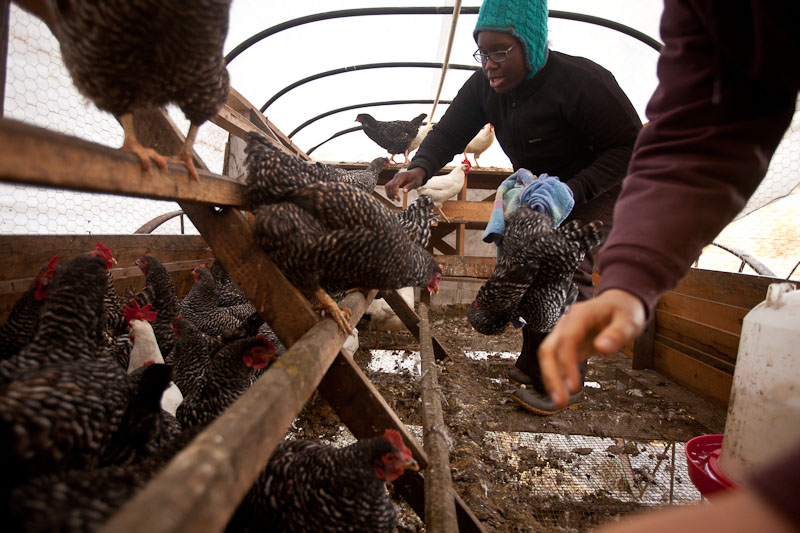 Our goal as farmers is to work toward the health of an entire ecological system. That system is made up of countless living creatures cycling through a continuous loop of nutrients. Living organisms in the soil decompose organic matter, which provides nutrients for plant growth. Those soil-borne nutrients then combine with the sun’s energy to fuel vigorous plants. These plants, in turn, feed the animals (ourselves included), which eventually die, returning to the soil to be broken down by microorganisms. This final step (along with animal manure) is crucial to feeding the next generation of plants. It is a beautiful system with no waste.Without cows and sheep and chickens to provide manure, the cycle breaks down, eventually depleting the soil. Farmers can use pesticides and fertilizers as a workaround, but ultimately these additives degrade and destroy the soil’s capacity to sustain life on its own.When I zoom out to this hawk’s-eye view, death is a sacred, essential link that makes the renewal of life possible. And when faced with a killing cone, that realization gets me half way there.
Our goal as farmers is to work toward the health of an entire ecological system. That system is made up of countless living creatures cycling through a continuous loop of nutrients. Living organisms in the soil decompose organic matter, which provides nutrients for plant growth. Those soil-borne nutrients then combine with the sun’s energy to fuel vigorous plants. These plants, in turn, feed the animals (ourselves included), which eventually die, returning to the soil to be broken down by microorganisms. This final step (along with animal manure) is crucial to feeding the next generation of plants. It is a beautiful system with no waste.Without cows and sheep and chickens to provide manure, the cycle breaks down, eventually depleting the soil. Farmers can use pesticides and fertilizers as a workaround, but ultimately these additives degrade and destroy the soil’s capacity to sustain life on its own.When I zoom out to this hawk’s-eye view, death is a sacred, essential link that makes the renewal of life possible. And when faced with a killing cone, that realization gets me half way there.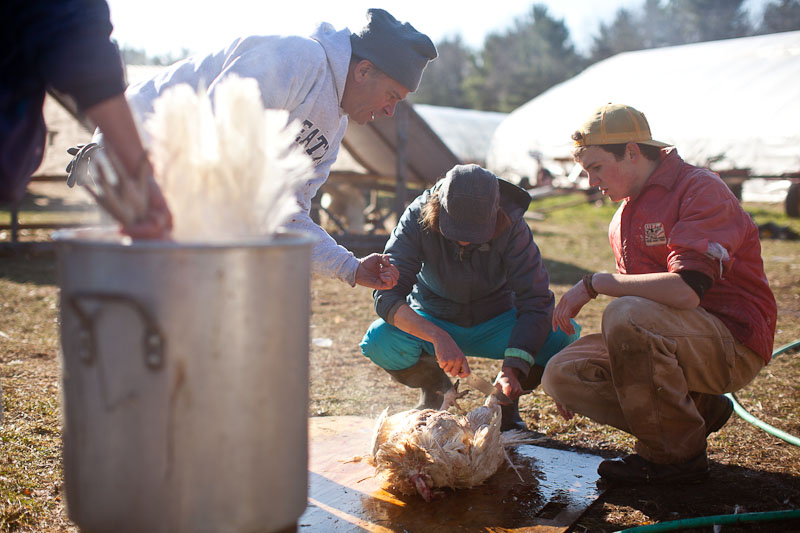 But put a turkey upside down in the blood-covered cone and I pause, knife in hand, struggling with my role in this cycle.Recently, I came across the words of Gene Logsdon, who notes that nature, too, is a cruel mother: “The only unnatural death in nature is a natural one,” by which he means that animals in the wild are almost never spared premature, scary and painful deaths. “Nature is a vast killing field,” he continues. “No bug, plant, or animal including humans can live unless other bugs, plants or animals die. All we do is trade corporeal forms around the gaming table of existential matter.”
But put a turkey upside down in the blood-covered cone and I pause, knife in hand, struggling with my role in this cycle.Recently, I came across the words of Gene Logsdon, who notes that nature, too, is a cruel mother: “The only unnatural death in nature is a natural one,” by which he means that animals in the wild are almost never spared premature, scary and painful deaths. “Nature is a vast killing field,” he continues. “No bug, plant, or animal including humans can live unless other bugs, plants or animals die. All we do is trade corporeal forms around the gaming table of existential matter.”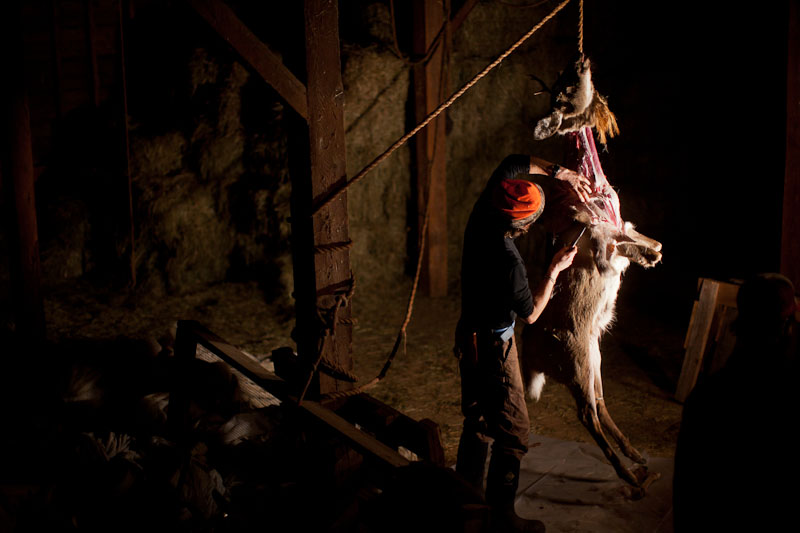 This idea is where my peace comes from. I do not and cannot live outside of this loop. My orientation then turns to ensuring that animals in my care live stress-free lives that allow them to express their natural tendencies. And when slaughter day comes, their deaths must be quick, without undue stress or prolonged painThis theory was put to the test on Thursday when we paid a visit to the killing floor of the Adams Farm slaughterhouse. It was a rare glimpse into the way that most animals in this country become the food we eat.When we arrived, the staff was deep in the process of culling a heard of yearling cattle. I was immediately impressed with how calm everything seemed, which ran up against my assumption that chaos ruled the day at slaughterhouses. The tennis-court sized room had concrete floors and metal walls. A conveyer belt of cows, hanging by hooves in various forms of dismemberment, moved slowly from right to left.First, a furry timid animal was coaxed to the bloody spot near the beginning of the conveyer belt. Once its head was locked into a stanchion, a worker placed a captive bolt gun on a golf ball-sized spot between its eyes. There was a quiet pop and the cow fell straight to the floor. Another worker then wrapped a chain around its left ankle, the cow was hoisted to the ceiling and its throat was slit. As the blood drained and pooled on the floor, its body went through its final, leaderless motions.The skinning came first. Cows are covered in e-coli bacteria, so they’re skinned according to a strict protocol, rolling the flesh away from the exposed meat. A small team of workers made a series of precise cuts, starting at the upper hooves. The skin was then clasped to chains that wound around a barrel, pulling the hide from the body as neatly as peeling a banana.The conveyer belt moved the lifeless cow to the next station where a worker cut through the sternum with a bow saw and sliced the belly vertically, releasing an avalanche of intestines and organs that fell into a cart to be repurposed later for chicken feed. The eviscerated cow was then cut neatly in half by a worker on a movable platform wielding a band saw unlike any I have ever seen.Once it reached the end of the conveyer belt, the final product was a study in anatomy: a halved carcasses, all muscle and bone, lacking any sign of the mooing life that imbued it a mere five minutes before.
This idea is where my peace comes from. I do not and cannot live outside of this loop. My orientation then turns to ensuring that animals in my care live stress-free lives that allow them to express their natural tendencies. And when slaughter day comes, their deaths must be quick, without undue stress or prolonged painThis theory was put to the test on Thursday when we paid a visit to the killing floor of the Adams Farm slaughterhouse. It was a rare glimpse into the way that most animals in this country become the food we eat.When we arrived, the staff was deep in the process of culling a heard of yearling cattle. I was immediately impressed with how calm everything seemed, which ran up against my assumption that chaos ruled the day at slaughterhouses. The tennis-court sized room had concrete floors and metal walls. A conveyer belt of cows, hanging by hooves in various forms of dismemberment, moved slowly from right to left.First, a furry timid animal was coaxed to the bloody spot near the beginning of the conveyer belt. Once its head was locked into a stanchion, a worker placed a captive bolt gun on a golf ball-sized spot between its eyes. There was a quiet pop and the cow fell straight to the floor. Another worker then wrapped a chain around its left ankle, the cow was hoisted to the ceiling and its throat was slit. As the blood drained and pooled on the floor, its body went through its final, leaderless motions.The skinning came first. Cows are covered in e-coli bacteria, so they’re skinned according to a strict protocol, rolling the flesh away from the exposed meat. A small team of workers made a series of precise cuts, starting at the upper hooves. The skin was then clasped to chains that wound around a barrel, pulling the hide from the body as neatly as peeling a banana.The conveyer belt moved the lifeless cow to the next station where a worker cut through the sternum with a bow saw and sliced the belly vertically, releasing an avalanche of intestines and organs that fell into a cart to be repurposed later for chicken feed. The eviscerated cow was then cut neatly in half by a worker on a movable platform wielding a band saw unlike any I have ever seen.Once it reached the end of the conveyer belt, the final product was a study in anatomy: a halved carcasses, all muscle and bone, lacking any sign of the mooing life that imbued it a mere five minutes before.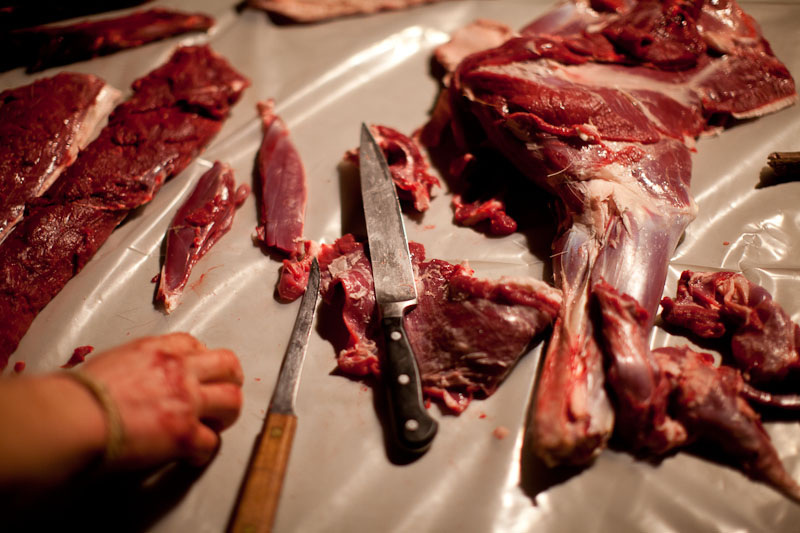 Animal by animal, each cow met its final moments with industrial efficiency, facing Mecca as mandated by Hallal requirements.As I watched the process unfold, my phone vibrated in my pocket. I ignored it. But it buzzed again. And again. On the third call, I dug the phone out. It was Dina – and if she called three times, it had to be important. I slipped out a side door and called her back.“I felt the baby move!” she exclaimed before even saying ‘hi.’Surreal is a good way to describe that moment. I tried to hold both realities in my brain: the hour I just spent watching life literally drain from huge and vital animals and the fact that Swisher, now 17-weeks in the making, was summoning a similar force of his own inside of Dina. From the hillside where I stood overlooking the town of Athol, I could touch both ends of the incredible continuum – and feel part of the fleeting middle of what what Margaret Atwood eloquently calls “God’s great dance of proteins.”The rest of the weeks photos can be found HERE...
Animal by animal, each cow met its final moments with industrial efficiency, facing Mecca as mandated by Hallal requirements.As I watched the process unfold, my phone vibrated in my pocket. I ignored it. But it buzzed again. And again. On the third call, I dug the phone out. It was Dina – and if she called three times, it had to be important. I slipped out a side door and called her back.“I felt the baby move!” she exclaimed before even saying ‘hi.’Surreal is a good way to describe that moment. I tried to hold both realities in my brain: the hour I just spent watching life literally drain from huge and vital animals and the fact that Swisher, now 17-weeks in the making, was summoning a similar force of his own inside of Dina. From the hillside where I stood overlooking the town of Athol, I could touch both ends of the incredible continuum – and feel part of the fleeting middle of what what Margaret Atwood eloquently calls “God’s great dance of proteins.”The rest of the weeks photos can be found HERE...
